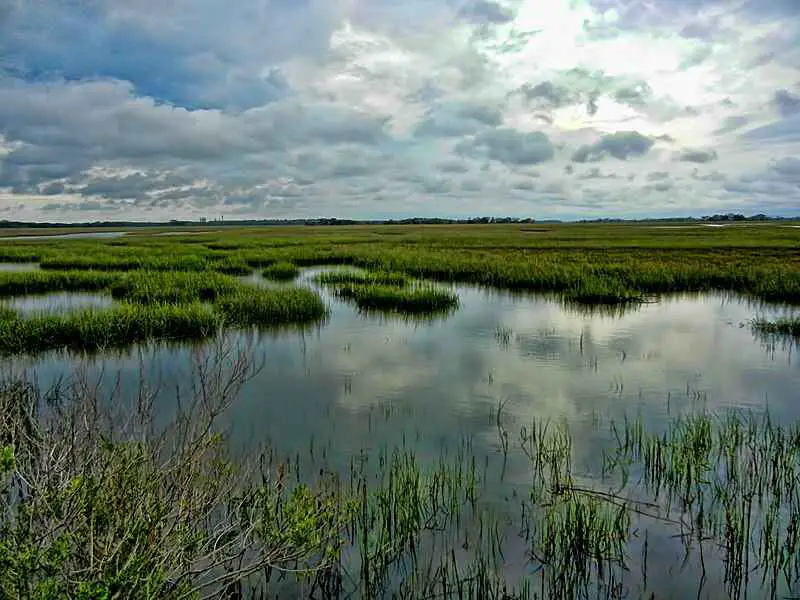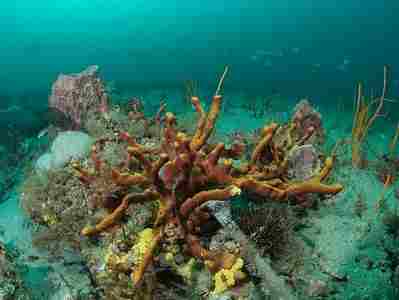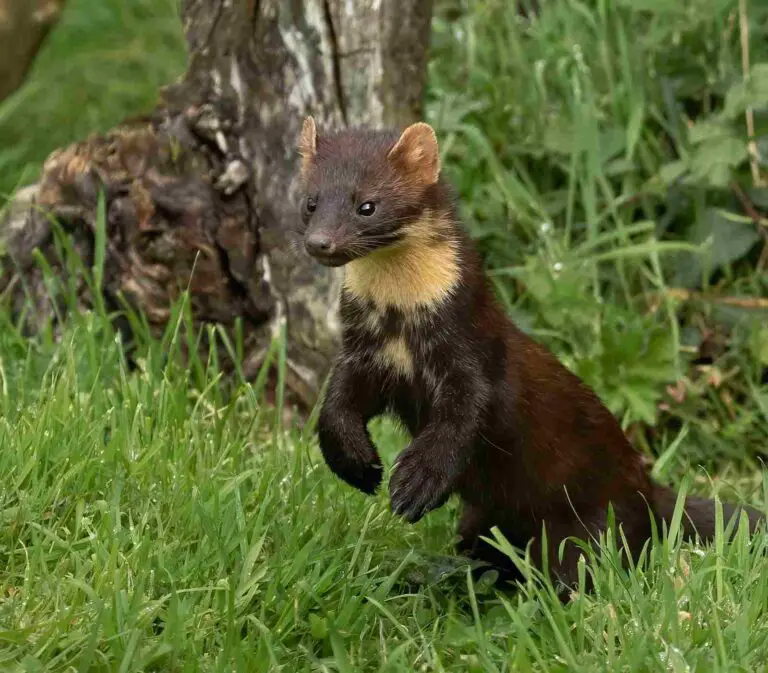5 Aquatic Ecosystem Types and Characteristics Explained
Aquatic ecosystem types are; marine surface, marine coastal, wetland, lentic and lotic ecosystems. They can be broadly classified into marine and freshwater aquatic ecosystems.
This article discusses the types of aquatic ecosystems and characteristics, as follows;
-Marine Aquatic Ecosystems
Types of marine aquatic ecosystems are; marine surface and marine coastal ecosystems.
1). Marine Surface Ecosystem (as one of the Aquatic Ecosystem Types)
The marine surface ecosystem is a type of aquatic ecosystem at is defined by the area of contact between large bodies of saltwater, and atmospheric gases.
One of the components of the marine surface ecosystem is called the Sea Surface Microlayer (SML), and it may be described as the interface occurring between the ocean and the atmosphere [7].
Marine surface ecosystem is unique for its level of exposure, which exceeds that of any other type of marine ecosystem, and causes it to have distinctive characteristics, by which it can be defined.
The characteristics of marine surface ecosystems include; large amount of dissolved gases, relatively-high level of solar penetration, high salinity and variable temperature.
In some studies, the marine surface ecosystem is measured according to the maximum reach of solar radiation, and may be placed at a depth of about 1 meter [2].
Marine surface ecosystem is unique for its role in introducing bioenergy into the ocean through photosynthesis. This means that marine trophic levels, food chains and energy pyramids commence from the marine surface ecosystem.
Exposure to the atmosphere also implies that various types of electromagnetic waves from sunlight may enter into the marine surface ecosystem, including ultraviolet and infrared waves.
These electromagnetic waves cause changes in thermal energy of oceans, which can be harnessed as a renewable energy resource, using ocean thermal conversion (OTEC) systems [6].
Organisms in the marine surface ecosystem are mostly producers like algae and Sargassum (golden seaweed).
It must be noted that most of the organic activity in aquatic marine ecosystems either restricted to, or directly dependent on, the surface. This is why the deep sea or ocean floor is not considered to be an ecologically active zone, or a type of aquatic ecosystem.
Also, the marine surface ecosystem plays a key role in determining how oceans affect the global environmental system, because they serve as the interface from which processes like ocean pollution, carbon sequestration, and climate change, may occur.

2). Marine Coastal Ecosystem
The marine coastal ecosystem (or coastal ocean ecosystem) is a highly diverse type of aquatic ecosystem that defines the zone where saltwater bodies like oceans, meet the land.
Because of its close link with terrestrial (land-based) ecosystems like forests; the marine coastal ecosystem is sometimes classified as a non-marine ecosystem [1]. Such opinions regarding the category under which this ecosystem falls, can also arise from the fact that marine coastal zones can be significantly shallow compared to the rest of the ocean.
Marine coastal ecosystem is diverse because its characteristics can vary widely with the conditions of the adjourning shore. The overlap of terrestrial and marine systems in coastal zones leads to high biodiversity and biological productivity, which can be measured in terms of the species richness and population size of these zones.
Examples of coastal marine ecosystems are; estuaries, mangroves, lagoons, coral reefs, and backwater zones. Adjourning ecological zones like islands, seagrass beds, and brackish marshes may also be considered part of the marine coastal ecosystem.
-Freshwater (and Brackish) Aquatic Ecosystems
Types of freshwater aquatic ecosystems are; wetlands, lentic and lotic ecosystems.
3). Wetland Ecosystem (as one of the Aquatic Ecosystem Types)
A wetland is a type of aquatic ecosystem that is dominated by either freshwater or saltwater, and characterized by water-saturated soil and shallow-depth water coverage.
Wetlands can be seen as products of perpetual flooding and inundation of land areas with water from a proximal water-body. They are very important for various reasons, including their natural role in mitigating hydrological hazards, as carbon sinks, and in the formation of natural energy resources like coal.
While they are mostly water-saturated, the hydrological levels in wetlands may vary with the seasons. These variations may also affect the physicochemical and biological conditions in these zones.
Characteristics of a wetland ecosystem are; water saturation, relatively-shallow water depth, hydrological and physicochemical variability, and dominance of hydrophyte vegetation. (Hydrophytes are plants adapted to partial or total submergence in water [5].
Three wetland ecosystems are bogs, marshes and swamps; which can be differentiated by the dominant type(s) of vegetation occurring in each. Generally, swamps dominantly contain wood vegetation like trees, bogs contain significant population of non-vascular plants like mosses, and marshes are dominated by herbaceous plants like grasses
As earlier stated, wetlands may be saltwater or freshwater-type. It is fairly common to find this type of aquatic ecosystem in-between marine and freshwater zones, so that some wetlands have both freshwater and saltwater characteristics, and are referred to as brackish wetlands.

4). Lentic Ecosystem
Lentic ecosystem is a type of aquatic ecosystem whose name derives from the Latin word; Lentus, which means immobile, motionless or slow; and it includes all biologically-active water bodies with little to no hydrological flow.
A lentic ecosystem can also be defined as a type of aquatic ecosystem that is characterized by slow water flow, so that hydrodynamic conditions are generally unchanging, and often entirely stagnant.
The slow-flow attribute of lentic ecosystems comes mostly from the fact that they comprise of water that is enclosed in a relatively narrow basin area, whose width, depth, and internal geomorphology do not allow for free hydrodynamic motion.
Examples of lentic ecosystems include; ditches, ponds, seeps, swamps, bogs marshes, ephemeral/seasonal pools, and lakes [4].
It must be noted that lentic and lotic types of aquatic ecosystems are classified based on velocity and trend of water flow; which is a different criteria from water quality, that is used to distinguish freshwater and saltwater ecosystems; or geographic situation, used to distinguish marine-surface and marine-coastal ecosystems).
In most cases, lentic ecosystems are freshwater systems.
Wetlands like bogs, swamps and marshes can be categorized as lentic when they are significantly submerged, because of the slow rate of water flow in these areas.
A consequence of slow water dynamics in lentic ecosystems is poor cycling (and recycling) or nutrients and oxygen, which in turn reduces biodiversity in such ecosystems compared to lotic, rapid-flowing water bodies.
In lentic ecosystems, vertical stratification is a very common feature that affects abiotic factors and physicochemical conditions like water quality, turbidity, pH, light penetration and salinity [3]. It implies that conditions tend to vary strongly with depth, as a result of low flow and mixing rates.

5). Lotic Ecosystem (as one of the Aquatic Ecosystem Types)
Lotic ecosystem derives from the Latin word; Lotus, which refers to the act of washing with water; and it includes all freshwater bodies characterized by significant flow rates and hydrodynamic processes.
The lotic ecosystem is also referred to as riverine ecosystem; after rivers which constitute a typical example of this system.
Creeks, brooks, rivers, and streams are all examples of lotic ecosystems, which can be distinguished by their continuous flow. Lotic ecosystems are also subject to seasonal changes, and have a very efficient mechanism of nutrient cycling that allows them to contain significant biodiversity.
Examples of lotic organisms are; aquatic reptiles like crocodiles, snakes and turtles; amphibians like frogs; mammals like hippopotamuses; and riparian plants like the weeping willow (Salix babylonica).
Lentic and lotic ecosystems are the two main types of freshwater-aquatic ecosystems, and are differentiated by their water-flow characteristics; where lentic ecosystems are slow-flowing and lotic systems are relatively-rapid in their flow.
The table below outlines lotic vs lentic ecosystems based on differences in examples, biodiversity, and hydrodynamic characteristics;
Comparison Criteria | Lotic Ecosystem | Lentic Ecosystem |
Relative Flow-Velocity | High | Low |
Relative Biodiversity | High | Low |
Dominant Mixing Mechanism | Gravitational Flow | Convective Cycling |
Physicochemical distribution | Non-Stratified | Stratified |
Examples | River, Creek, Stream, Brook, Spring | Pond, Lake, Marsh, Bog, Swamp, Seasonal Pool |
Conclusion
Types of aquatic ecosystems are;
1. Marine Surface Ecosystem
2. Marine Coastal Ecosystem
3. Wetland Ecosystem
4. Lentic Ecosystem
5. Lotic Ecosystem
References
1). Carrasco De La Cruz, P. M. (2021). "The Knowledge Status of Coastal and Marine Ecosystem Services - Challenges, Limitations and Lessons Learned From the Application of the Ecosystem Services Approach in Management." Front. Mar. Sci. 8:684770. Available at: https://doi.org/10.3389/fmars.2021.684770. (Accessed 13 April 2023).
2). Helm, R. R. (2021). "The mysterious ecosystem at the ocean's surface." PLoS Biol. 2021 Apr 28;19(4):e3001046. Available at: https://doi.org/10.1371/journal.pbio.3001046. (Accessed 13 April 2023).
3). Marsh, G. A.; Fairbridge, R. W. (1999). "Lentic and lotic ecosystems. In: Environmental Geology." Encyclopedia of Earth Science. Springer, Dordrecht. Available at: https://doi.org/10.1007/1-4020-4494-1_204. (Accessed 12 April 2023).
4). Reinbold, J. (2018). "Lentic & Lotic Ecosystems." Available at: https://sciencing.com/lentic-lotic-ecosystems-7355077.html. (Accessed 12 April 2023).
5). Rodrigo, M. A. (2021). "Wetland Restoration with Hydrophytes: A Review." Plants 2021, 10, 1035. Available at: https://doi.org/10.3390/plants10061035. (Accessed 13 April 2023).
6). Tinaikar, A. (2013). "Ocean Thermal Energy Conversion." International Journal of Energy and Power Engineering 2(4):143. Available at: https://doi.org/10.11648/j.ijepe.20130204.11. (Accessed 13 April 2023).
7). Wurl, O.; Ekau, W.; Landing, W.; Zappa, C. J. (2017). "Sea surface microlayer in a changing ocean – A perspective." Elem Sci Anth 5(31). Available at: https://doi.org/10.1525/elementa.228. (Accessed 13 April 2023).




